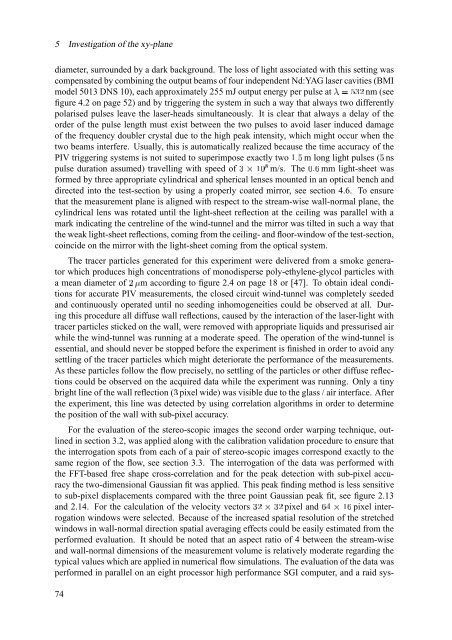The significance of coherent flow structures for the turbulent mixing ...
The significance of coherent flow structures for the turbulent mixing ...
The significance of coherent flow structures for the turbulent mixing ...
Create successful ePaper yourself
Turn your PDF publications into a flip-book with our unique Google optimized e-Paper software.
5 Investigation <strong>of</strong> <strong>the</strong> xy-plane<br />
diameter, surrounded by a dark background. <strong>The</strong> loss <strong>of</strong> light associated with this setting was<br />
compensated by combining <strong>the</strong> output beams <strong>of</strong> four independent Nd:YAG laser cavities (BMI<br />
model 5013 DNS 10), each approximately 255 mJ output energy per pulse ×XØ È¿Â0Û at nm (see<br />
figure 4.2 on page 52) and by triggering <strong>the</strong> system in such a way that always two differently<br />
polarised pulses leave <strong>the</strong> laser-heads simultaneously. It is clear that always a delay <strong>of</strong> <strong>the</strong><br />
order <strong>of</strong> <strong>the</strong> pulse length must exist between <strong>the</strong> two pulses to avoid laser induced damage<br />
<strong>of</strong> <strong>the</strong> frequency doubler crystal due to <strong>the</strong> high peak intensity, which might occur when <strong>the</strong><br />
two beams interfere. Usually, this is automatically realized because <strong>the</strong> time accuracy <strong>of</strong> <strong>the</strong><br />
PIV triggering systems is not suited to superimpose exactly two ÆÁÌÈ m long light pulses (È ns<br />
pulse duration assumed) travelling with speed <strong>of</strong> †ÄÐƾzy m/s. <strong>The</strong> ¾ÁÃß mm light-sheet was<br />
<strong>for</strong>med by three appropriate cylindrical and spherical lenses mounted in an optical bench and<br />
directed into <strong>the</strong> test-section by using a properly coated mirror, see section 4.6. To ensure<br />
that <strong>the</strong> measurement plane is aligned with respect to <strong>the</strong> stream-wise wall-normal plane, <strong>the</strong><br />
cylindrical lens was rotated until <strong>the</strong> light-sheet reflection at <strong>the</strong> ceiling was parallel with a<br />
mark indicating <strong>the</strong> centreline <strong>of</strong> <strong>the</strong> wind-tunnel and <strong>the</strong> mirror was tilted in such a way that<br />
<strong>the</strong> weak light-sheet reflections, coming from <strong>the</strong> ceiling- and floor-window <strong>of</strong> <strong>the</strong> test-section,<br />
coincide on <strong>the</strong> mirror with <strong>the</strong> light-sheet coming from <strong>the</strong> optical system.<br />
<strong>The</strong> tracer particles generated <strong>for</strong> this experiment were delivered from a smoke generator<br />
which produces high concentrations <strong>of</strong> monodisperse poly-ethylene-glycol particles with<br />
a mean diameter <strong>of</strong> Û@Õ m according to figure 2.4 on page 18 or [47]. To obtain ideal conditions<br />
<strong>for</strong> accurate PIV measurements, <strong>the</strong> closed circuit wind-tunnel was completely seeded<br />
and continuously operated until no seeding inhomogeneities could be observed at all. During<br />
this procedure all diffuse wall reflections, caused by <strong>the</strong> interaction <strong>of</strong> <strong>the</strong> laser-light with<br />
tracer particles sticked on <strong>the</strong> wall, were removed with appropriate liquids and pressurised air<br />
while <strong>the</strong> wind-tunnel was running at a moderate speed. <strong>The</strong> operation <strong>of</strong> <strong>the</strong> wind-tunnel is<br />
essential, and should never be stopped be<strong>for</strong>e <strong>the</strong> experiment is finished in order to avoid any<br />
settling <strong>of</strong> <strong>the</strong> tracer particles which might deteriorate <strong>the</strong> per<strong>for</strong>mance <strong>of</strong> <strong>the</strong> measurements.<br />
As <strong>the</strong>se particles follow <strong>the</strong> <strong>flow</strong> precisely, no settling <strong>of</strong> <strong>the</strong> particles or o<strong>the</strong>r diffuse reflections<br />
could be observed on <strong>the</strong> acquired data while <strong>the</strong> experiment was running. Only a tiny<br />
bright line <strong>of</strong> <strong>the</strong> wall reflection (Â pixel wide) was visible due to <strong>the</strong> glass / air interface. After<br />
<strong>the</strong> experiment, this line was detected by using correlation algorithms in order to determine<br />
<strong>the</strong> position <strong>of</strong> <strong>the</strong> wall with sub-pixel accuracy.<br />
For <strong>the</strong> evaluation <strong>of</strong> <strong>the</strong> stereo-scopic images <strong>the</strong> second order warping technique, outlined<br />
in section 3.2, was applied along with <strong>the</strong> calibration validation procedure to ensure that<br />
<strong>the</strong> interrogation spots from each <strong>of</strong> a pair <strong>of</strong> stereo-scopic images correspond exactly to <strong>the</strong><br />
same region <strong>of</strong> <strong>the</strong> <strong>flow</strong>, see section 3.3. <strong>The</strong> interrogation <strong>of</strong> <strong>the</strong> data was per<strong>for</strong>med with<br />
<strong>the</strong> FFT-based free shape cross-correlation and <strong>for</strong> <strong>the</strong> peak detection with sub-pixel accuracy<br />
<strong>the</strong> two-dimensional Gaussian fit was applied. This peak finding method is less sensitive<br />
to sub-pixel displacements compared with <strong>the</strong> three point Gaussian peak fit, see figure 2.13<br />
and 2.14. For <strong>the</strong> calculation <strong>of</strong> <strong>the</strong> velocity Â0ÛÓÄœÂ0Û vectors pixel ß¿ËFÄ Æß and pixel interrogation<br />
windows were selected. Because <strong>of</strong> <strong>the</strong> increased spatial resolution <strong>of</strong> <strong>the</strong> stretched<br />
windows in wall-normal direction spatial averaging effects could be easily estimated from <strong>the</strong><br />
per<strong>for</strong>med evaluation. It should be noted that an aspect ratio <strong>of</strong> 4 between <strong>the</strong> stream-wise<br />
and wall-normal dimensions <strong>of</strong> <strong>the</strong> measurement volume is relatively moderate regarding <strong>the</strong><br />
typical values which are applied in numerical <strong>flow</strong> simulations. <strong>The</strong> evaluation <strong>of</strong> <strong>the</strong> data was<br />
per<strong>for</strong>med in parallel on an eight processor high per<strong>for</strong>mance SGI computer, and a raid sys-<br />
74
















